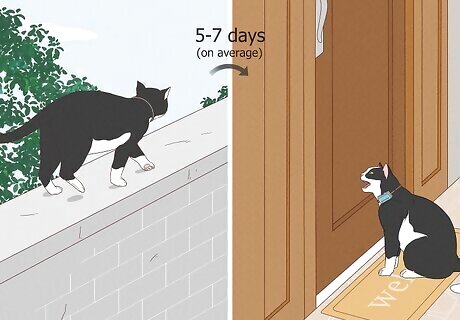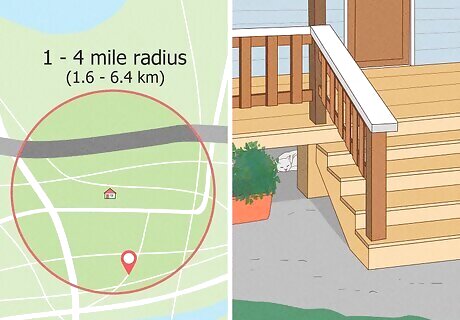
views
Reasons That Cats Run Away from Home

They’re being curious and are off exploring. Many cats have a naturally curious personality and will want to jet off during the day and explore. Maybe your cat is chasing birds and bugs, trekking around nearby parks, or befriending other people and pets in your neighborhood. Sometimes, your cat may end up on an adventure that takes them away from home for hours, days, or weeks. What can you do? If you want your cat to satisfy their outdoor curiosity while staying safe as an indoor cat, build them a catio or leash train them. You can also give them a GPS tracking collar—like this one from Tractive—so that you can easily keep track of where they are from an app on your phone.

They want to hunt. Cats are hunters by nature—even if you can hardly imagine your cuddly furball stalking down some prey! Hunting behavior is deeply ingrained in felines, and hunting toys indoors isn’t enough to satisfy the predatory urge for all housecats. What can you do? Give your cat as much enrichment as possible in the home. Look for toys that will provide more of a challenge for them (i.e., a robotic bird or snake that moves on its own) so that they’ll be less tempted to head outside for hunting.

They’re looking for more food sources. If your cat has stumbled upon a free source of food elsewhere, they may seek it out if they want something more to snack on. These food sources could be a nearby neighbor who’s feeding your cat, a dumpster, or any other source of “free” food. What can you do? Make sure that your cat is getting an appropriate amount of food as well as some treats to keep them full and satisfied.

They’re in heat and looking for a mate. Male cats may travel from home to find a female cat in heat, while female cats in heat might escape their home to find a suitable male cat to breed with. If your cat is unneutered or unspayed, they’re significantly more likely to leave their home in order to find a mate. Unneutered cats are also more likely to use aggression against other cats in order to defend their mates or their territory, so there’s also a greater risk of your cat being injured while away from home. What can you do? Spay or neuter your cat so that they won’t go searching for a mate.

They’re defending their territory. Cats are naturally territorial and will claim the area around your home as “theirs.” If there aren’t any other cats living nearby, your cat may extend the borders of its territory and go exploring farther than you’d expect. As a result, your cat may be gone for a few days, leading you to fear that they’re “missing.” What can you do? Keep your cat indoors or put a GPS tracking collar on them. With a device like Tractive’s Smart Cat Collar, you can set virtual fences to keep your cat safe—not only can you track your cat’s location at any time, but you’ll also get “escape alerts” if they leave your virtually fenced-in zone.

They have a second home or owner. As sad as it sounds, some cats do find a second family and build a double life for themselves. If they’ve met a neighbor who’s friendly, affectionate, and willing to give them food and shelter, they may decide to spend long stretches of time at their home instead of yours. What can you do? Train your cat to come when called, and give your cat a collar so that your neighbors know that it already has a home. By adding a tracker like Tractive to your cat's collar, you can even train your cat to come home by triggering the collar's built-in sound function.

They’re preparing to give birth. When pregnant cats are preparing to give birth, they’ll look for a quiet and secluded space where they feel safe and protected. If your cat is unable to find a hiding spot in your home, she may look for an outside area in which to give birth. What can you do? Create a safe space inside your home for your pregnant cat to give birth and nurse in. If your cat is pregnant, you may want to get ahead of the issue by giving her a GPS tracking collar like the Tractive Smart Collar—that way, if you suspect she’s holed up somewhere in labor, you’ll be able to find her faster and get her the help she needs.

They feel stressed or afraid. Cats are very sensitive and dislike any unwanted changes to their home, space, and routine. As a result, any significant changes (e.g., new pets, renovations, new babies, furniture rearranging) may spook your cat enough for them to run away—especially if they can’t find a secure place to hide at home and get peace and quiet until things settle down. They could also feel scared due to random events like fireworks, being chased by a dog, or another fear-inducing event that causes them to go into fight-or-flight mode. What can you do? Create a safe, quiet, and secluded space in your home where your cat can feel completely alone and protected. If you’re bringing new animals into the home, introduce them slowly and according to your vet’s recommendations. If you anticipate some stress in the home (i.e., fireworks), give them a calming treat, calming cat suit, or prescribed pheromones.

They feel neglected or abandoned. If your cat doesn’t feel cared for at home, they may choose to leave. Generally, this happens because your cat isn’t getting enough food, water, or affection. If you leave your cat alone for long stretches of time and they run out of food and water, they may think they’ve been abandoned and will look elsewhere for something to eat. The same goes for if you don’t supply them with a clean, comfortable place to sleep or use the bathroom. What can you do? Give your cat plenty of attention and enrichment, and make sure they’re getting the veterinarian-recommended amount of food and water. Supply them with multiple resting places and enough litter boxes for the number of cats in your home (and clean them regularly!).

They feel sick or like they’re dying. If a cat feels sick, ill, or even like they’re dying, they’ll instinctively look for somewhere safe to hide. If they can’t find a secure spot inside your home, they may look outside. Since they’re already ill, these cats are highly vulnerable to predators and other neighborhood cats, so it’s extra important to prevent them from leaving when sick and to find them if they do. However, these cats usually won’t go too far from home—they’ll just head to the closest available hiding spot. What can you do? If your cat shows any signs of sickness, take them to the vet as soon as possible. Be sure to create small hiding spots for your cat inside your home so that they’ll be less likely to wander off. Some tracking collars, like the Tractive Smart Cat Collar, will even give you updates about your cat’s rest and exercise levels, which may help you to spot health issues early and prevent your cat from hiding in the first place. Do cats really run away when they’re dying? Cats don’t run off because they know they’re going to die—however, if they’re not feeling well, they’ll look for a safe and quiet place to hide so that they’re better protected from predators in their weakened state. So, in some cases, a dying cat will run away to a hiding spot and end up passing away there.
Do cats come back when they run away?

While there’s no guarantee, the majority of cats return after running away. Cats like to escape and explore, so many cats do just that before coming home to their owners—even days or weeks later. When cats “go missing,” they’re most statistically likely to return after 5-7 days (on average), and they’re usually found within 4 miles (6.4 km) of their home. If you want to know where your cat gets off to, use a GPS-tracking collar to keep an eye on them and make sure their safe while off on their adventures. This one from Tractive lasts for up to seven days without charging and works anywhere that you get cell service, so you’ll have ample time to find out where your cat is and go out searching for it, if needed. What if a cat leaves and never comes back? Unfortunately, some cats don’t return home after going missing. Usually, that happens for one of the following reasons: They’re injured, sick, or trapped somewhere nearby. They’ve been rounded up by animal control. They’ve been stolen (which is more common for valuable breeds). They’ve been preyed upon by wild animals (e.g., cougars, wolves, coyotes, snakes, birds, etc.). They’ve hidden somewhere and died of natural causes or illness.
Where do cats go when they run away?

When cats run away, they usually hide or explore somewhere nearby your home. In most cases, cats that “run away” from home stay within a 1 mile (1.6 km) radius—at most, they might explore up to 4 miles (6.4 km) away from your house. Outdoor cats are more likely to roam farther, while indoor cats will rarely go very far on their own. Most often, escaped cats are found hiding in small, quiet, and secure places where they feel safe and out of sight—perhaps because they’ve been injured, frightened, or are just roaming about looking for prey or adventure. If your cat’s gone missing, consider checking the following common hiding spots: Under decks, porches, and stairs. In and around garages and sheds. In and under cars (including around the engine and wheel wells). In thick shrubs or bushes. In attics, crawl spaces, or basements. In barns, greenhouses, and laundry rooms. Be sure to check both your home and your neighbors’ homes (with permission). If you have a GPS tracker on your cat, you should be able to easily find them by looking up their exact location. The Tractive Smart Cat Collar, for instance, lets you track your cat with live GPS and no distance limit. You can also find out where they’ve liked to explore and hide in the past.
How do cats find their way home?

Cats use a homing instinct, along with familiar surroundings, to find their way home. Like humans, cats get to know the area around their home and use that knowledge of their surroundings to find their way back after wandering off. However, cats also have a special homing instinct that helps them to find their way home when they’ve strayed too far from their familiar territory. We’ve yet to fully understand how this homing mechanism (also known as PSI trailing) works, but limited studies have posited that it may be linked to scent cues and the Earth’s geomagnetic field. According to these studies, all animals have this unique ability to return home from a great distance. However, pets who’ve lived both indoors and outdoors are best equipped to do this, and some cats—like humans—may be naturally more directionally savvy than others. What if it’s a new home? If you’ve recently moved to a new home, then your cat may not have memorized the area as “home” quite yet—this can take anywhere from a few days to a couple of months. If your cat lived in your old home for a long time, they may try to return there instead. Ask the new residents and your old neighbors to keep an eye out for your cat. If you’re able to travel there yourself, it’s worth making the trek to look for your pet. If you’re about to move to a new home with an outdoor cat, consider investing in a GPS tracking collar (like the from Tractive, which comes with an award-winning safety release collar), since it’s quite likely that your cat will try to run back to their old home before they become fully acclimated to their new one. What if a lot of time has passed? Cats can still use their homing instincts to find their way home after days, weeks, months, or even years—it’s happened before, so it could happen to you! Cats have even been known to travel up to 50–80 miles (80–129 km) in 2.5 years before returning home. That being said, most cats are found within 5 metres (0.0031 mi) of where they escaped, where it’s easier for them to use scent cues and PSI trailing. Just don’t give up hope—keep checking animal shelters and neighborhood groups for as long as possible!
How to Find a Lost Cat

If your cat is lost, look around your neighborhood and spread the word. Most missing cats stay close to home, so it’s possible that your cat is closer than you think—they could even be hiding somewhere on your property or around your neighbor’s home. It’s important to be proactive, so as soon as you realize your cat is lost, start taking the following steps: Walk around your house and neighborhood calling your cat’s name and shaking a box of treats. If they have a favorite toy that makes noise, bring that as well. It’s best to search around dusk and dawn (when cats usually feel safest to be out and about). Put your cat’s bed or blanket outside to entice them to come lie on it. Ask your neighbors to check around their homes, including their garages, sheds, crawl spaces, and cars. Post or pass out “Missing Cat” flyers in your neighborhood and community. Include a clear and recent photo of your cat along with any unique identifying details, your contact info, and a reward (if possible). Post your “Missing Cat” flyer on social media, including any neighborhood groups and websites like Pet FBI. Call any nearby veterinary offices, rescue centers, and animal control centers to see if your cat has been picked up or turned in. Install a motion-sensitive camera in your backyard so you can see if your cat is still visiting your backyard at night. If you have a tracking device on your cat, use it to find their GPS location and head to that spot. For instance, a device like the Tractive Smart Cat Collar lets you track your cat’s live location on your phone. There’s no distance limit on the device, and it works anywhere that Verizon, T-Mobile, or AT&T has coverage Don’t give up! Cats have been known to disappear for days, weeks, and even months at a time before returning home to their owner.
How to Prevent a Cat from Running Away

Consider preventative tools like GPS collars, microchips, leash training, and more. If you have a cat that spends time outdoors (or frequently tries to escape to the outdoors), it’s crucial to do all you can to prevent them from running away or getting lost outside. One of the best ways to keep your cat safe and close by is to get a GPS tracking collar. We recommend the Smart Cat Collar from Tractive, which allows you to track your cat from your phone, provides live location updates, and sends escape alerts when your cat leaves your pre-designated “safety zone.” The safety release collar can also track your cat’s activity levels and alert you to any potential health issues that may cause your pet to run away. Other ways to prevent your cat from escaping or being kept away from your home include: Keeping your windows and doors closed shut whenever possible (if you have an indoor cat). If you’ve recently moved, keep your cat indoors for at least a month before letting them venture outside. Keeping your cat safely contained when traveling. Leash-training your cat so that it can explore outside while still being safe and unable to flee. Creating a catio (or outdoor cat enclosure) so that your cat can enjoy the outdoors without any risk. Having your cat spayed or neutered so that they’re less likely to leave home to seek a mate (or give birth). Microchipping your cat (and keeping your contact details updated) so that they can be traced back to you once found. Making sure your cat has the best home environment possible—give them plenty of food, water, toys, affection, enrichment, and clean places to use the bathroom and sleep. Be cautious when introducing new animals and humans into the home so that your cat doesn’t feel stressed, scared, or neglected enough to run away from you.
Frequently Asked Questions About Cats Running Away
Why do cats run away from you inside the house? Cats will sometimes randomly run away from even their most loved humans, but the reasons why are varied and nuanced. Sometimes, cats just want to be alone and don’t feel like being touched or socialized with—in this case, your cat might just run off to another room or out of your reach. In other cases, your cat might be feeling scared, stressed, or territorial—especially if you’ve recently altered their environment with a loud noise, unfamiliar person, new pet, or furniture rearrangement. If your cat wasn’t properly socialized as a kitten or was formerly a stray, they may also feel more fearful around humans and be more prone to running away at random times. If your cat is suddenly running away from you more often than it ever has before, it may indicate an underlying medical issue, so you may want to take it to see a vet.
Do male and female cats run away for different reasons? In general, male and female cats run away for the same common reasons—e.g., fear, stress, hunting, exploration, etc. However, there are some reproductive differences between male and female cats that give them different reasons to escape the home. Male cats (especially unneutered ones) have a strong reproductive drive, so they may leave the house in order to find a mate. They might also want to mark their territory outside in order to defend it from other males. A female cat, on the flip side, may escape to find a male mate after she goes into heat (particularly if she hasn’t been spayed).




















Comments
0 comment